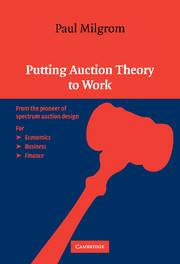Book contents
- Frontmatter
- Contents
- Preface
- Foreword by Evan Kwerel
- PUTTING AUCTION THEORY TO WORK
- 1 Getting to Work
- PART I THE MECHANISM DESIGN APPROACH
- 2 Vickrey–Clarke–Groves Mechanisms
- 3 The Envelope Theorem and Payoff Equivalence
- 4 Bidding Equilibrium and Revenue Differences
- 5 Interdependence of Types and Values
- 6 Auctions in Context
- PART II MULTI-UNIT AUCTIONS
- Bibliography
- Author Index
- Subject Index
- References
5 - Interdependence of Types and Values
Published online by Cambridge University Press: 05 June 2012
- Frontmatter
- Contents
- Preface
- Foreword by Evan Kwerel
- PUTTING AUCTION THEORY TO WORK
- 1 Getting to Work
- PART I THE MECHANISM DESIGN APPROACH
- 2 Vickrey–Clarke–Groves Mechanisms
- 3 The Envelope Theorem and Payoff Equivalence
- 4 Bidding Equilibrium and Revenue Differences
- 5 Interdependence of Types and Values
- 6 Auctions in Context
- PART II MULTI-UNIT AUCTIONS
- Bibliography
- Author Index
- Subject Index
- References
Summary
Most of the models in chapters 2–4 are independent private values models. Values are private if each player's value for any outcome depends only on his own type and independent if types are statistically independent. The only exceptions so far are the Jehiel–Moldovanu model of chapter 3, which discards the private values assumption, and the correlated-types example of chapter 4, which relaxes the independence assumption.
Relaxing the private values and independence assumptions raises a host of new issues. When bidders do not know their own values, the connection between bids and values is naturally weaker and the bidder with the highest value may win less often. Bidders' ignorance of their values leads us to study what information bidders are likely to acquire, whether they Will share this information or keep it secret, and whether the auctioneer can improve the outcome by gathering and disseminating information on its own. The independence assumption is an essential premise of the Myerson's lemma and the revenue equivalence theorems. Relaxing this assumption forces us to reevaluate the most basic results of auction theory.
In this chapter, we study issues raised by the two possible kinds of interdependence. Section 5.1 investigates the kinds of simplifying assumptions that are “reasonable” and “useful” in auction models. Section 5.2 explores the consequences of statistically interdependent types in an optimal auction model. Section 5.3 studies the empirically successful drainage tract model, which treats bidding for oil on tracts adjacent to a previously developed tract.
- Type
- Chapter
- Information
- Putting Auction Theory to Work , pp. 157 - 207Publisher: Cambridge University PressPrint publication year: 2004
References
- 2
- Cited by



